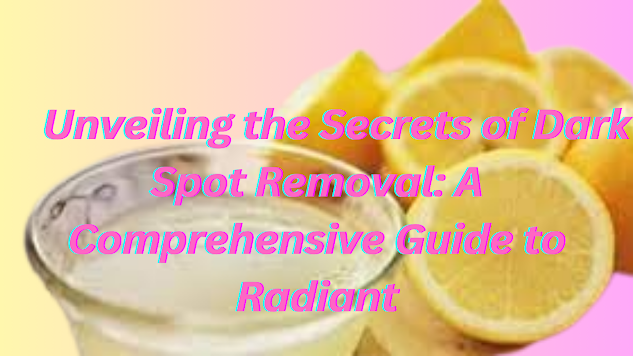- The Secrets of Dark Spot Removal:
Dark spots on the face, also known as hyperpigmentation, can be a source of distress for many individuals. These spots can be caused by various factors, including sun exposure, hormonal changes, aging, and skin injuries. However, the good news is that there are numerous methods and treatments available to address and eliminate these unwanted blemishes. In this comprehensive guide, we will explore the causes of dark spots, different types of hyperpigmentation, and delve into a variety of treatments to achieve a clear and radiant complexion.
- Understanding the Causes of Dark Spots:
- Sun Exposure:
One of the primary causes of dark spots is prolonged exposure to the sun. The ultraviolet (UV) rays from the sun can stimulate the production of melanin, the pigment responsible for skin color. Excessive sun exposure can lead to an overproduction of melanin, resulting in the formation of dark spots.
- Hormonal Changes:
Hormonal fluctuations, particularly during pregnancy or the use of birth control pills, can trigger the development of dark spots. This type of hyperpigmentation, known as melasma, often appears as patches on the face and is commonly referred to as the "mask of pregnancy."
- Aging:
As we age, our skin undergoes various changes, including a decrease in collagen production and slower cell turnover. These changes can contribute to the accumulation of melanin in certain areas, leading to the formation of age spots or liver spots.
- Inflammation and Skin Injuries:
Skin injuries, such as acne or wounds, can leave behind dark spots during the healing process. Inflammation can also contribute to hyperpigmentation, making it essential to address skin conditions promptly to prevent the formation of dark spots.
- Types of Hyperpigmentation:
- Sunspots or Solar Lentigines:
Sunspots, also known as solar lentigines or age spots, are darkened areas of the skin caused by prolonged exposure to UV rays. They typically appear on areas of the skin that receive the most sun exposure, such as the face, hands, and shoulders.
- Melasma:
Melasma is a form of hyperpigmentation characterized by brown or grayish patches on the face, particularly on the cheeks, forehead, and upper lip. Hormonal changes, such as those during pregnancy or with the use of oral contraceptives, can trigger melasma.
- Post-Inflammatory Hyperpigmentation (PIH):
PIH occurs as a result of inflammation or injury to the skin, leading to the darkening of the affected area. This type of hyperpigmentation is common in individuals with darker skin tones and can be caused by acne, cuts, or burns.
- Freckles:
Freckles are small, flat, brown spots that often appear on sun-exposed areas of the skin. They are usually genetic and can darken with sun exposure.
- Treatment Options for Dark Spot Removal:
- Topical Treatments:
Hydroquinone: A skin-lightening agent that inhibits melanin production. It is available in over-the-counter and prescription formulations.
Retinoids: Derived from vitamin A, retinoids promote cell turnover and help fade dark spots. They are available in both prescription and over-the-counter formulations.
Vitamin C: A powerful antioxidant that can brighten the skin and inhibit melanin production. Vitamin C serums are popular for treating dark spots.
Alpha Hydroxy Acids (AHAs) and Beta Hydroxy Acids (BHAs): These chemical exfoliants help remove dead skin cells, promoting a more even skin tone. Examples include glycolic acid (AHA) and salicylic acid (BHA).
- Laser Therapy:
Laser treatments, such as intense pulsed light (IPL) and fractional laser therapy, can target dark spots and break down excess melanin. These procedures are typically performed by dermatologists and require multiple sessions for optimal results.
- Chemical Peels:
Chemical peels involve applying a chemical solution to the skin, causing it to exfoliate and peel off. This process helps improve skin texture and reduce the appearance of dark spots. Peels can vary in intensity, with superficial peels suitable for mild hyperpigmentation and deeper peels for more severe cases.
- Microdermabrasion:
Microdermabrasion is a non-invasive exfoliation technique that uses a machine to remove the outer layer of dead skin cells. This treatment can help improve the appearance of dark spots and enhance overall skin texture.
- Cryotherapy:
Cryotherapy involves freezing dark spots with liquid nitrogen, causing them to peel off. This method is commonly used for the removal of small, isolated dark spots.
- Prescription Medications:
Dermatologists may prescribe medications such as topical steroids or combination creams containing multiple active ingredients to address specific types of hyperpigmentation.
- Preventive Measures:
- Sun Protection:
Preventing further sun damage is crucial in managing and preventing dark spots. Use broad-spectrum sunscreen with a high SPF daily, wear protective clothing, and seek shade during peak sunlight hours.
- Gentle Skincare Routine:
Adopt a gentle skincare routine that includes mild cleansers and avoids harsh scrubs. Excessive exfoliation can irritate the skin and exacerbate hyperpigmentation.
- Avoid Picking at the Skin:
Resist the urge to pick at acne or blemishes, as this can lead to inflammation and increase the risk of post-inflammatory hyperpigmentation.
- Hormonal Balance:
For individuals experiencing hormonal-related dark spots, consult with a healthcare professional to explore options for hormonal balance.
- Conclusion:
Dark spot removal requires a multifaceted approach, combining topical treatments, professional procedures, and preventive measures. It's essential to consult with a dermatologist to determine the most suitable treatment plan based on the type and severity of hyperpigmentation. With patience and consistent care, achieving a clear and radiant complexion is within reach for individuals dealing with dark spots on the face.


.png)
.png)




.png)


.png)
0 Comments